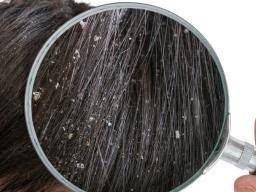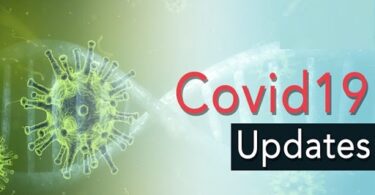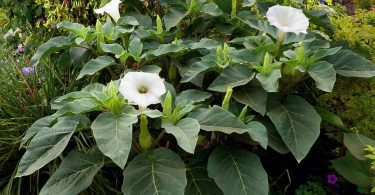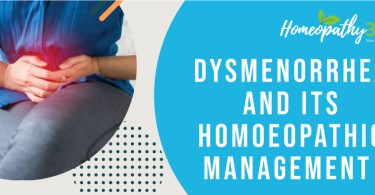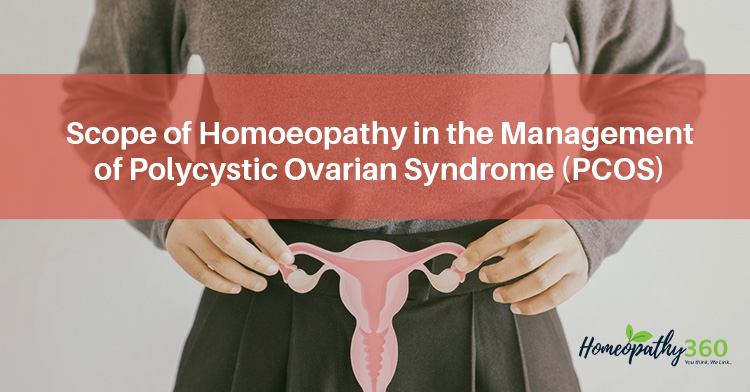
ABSTRACT: This underlying cause is responsible for roughly 80% of all cases of anovulatory fertility problems. It is a condition characterized by amenorrhea, hirsutism, increased ovarian size, and obesity. The purpose of this article is to discuss several homoeopathic treatments for PCOS. [1][2][3]
KEYWORDS: Polycystic ovarian syndrome, amenorrhoea, hirsutism, homoeopathy
ABBREVIATIONS: LH- luteinizing hormone, FSH- follicle- stimulating hormone, BMI- body mass index, DUB- dysfunctional uterine bleeding, LDL- low-density lipoprotein, HDL- high-density lipoprotein, CAH- congenital adrenal hyperplasia, SHBG- sex hormone binding globulin, IR- insulin resistance, DHEAS- dehydroepiandrosterone sulfate, IGT- impaired glucose tolerance.
INTRODUCTION:
Polycystic ovarian syndrome (PCOS) was first recognized by Stein and Leventhal in 1935 as a condition distinguished by amenorrhea, hirsutism, and obesity, as well as multiple large cysts in the ovary.
This disease is distinguished by increased androgen production in the ovaries. [4][5]
AETIOLOGY:
PCOS’s pathophysiology is not entirely understood. Approximately 60% of PCOS patients have hypersecretion of LH (LH increases androgen secretion from ovarian thecal cells). Though frequently observed, an elevated LH: FSH ratio is not necessary for diagnosis.
These elements have been connected:
• Genetics (clustering of families).
• Insulin resistance (insulin receptor deficiency) is being compensated for by hyperinsulinemia.
• Hyperandrogenism (increased ovarian androgen production).
• Obesity: 35–60% of women with PCOS have a BMI over 30.
• Worsens insulin resistance. [6][7][8]
PATHOGENESIS: [3]
Due to the differing characteristics of this condition, there are several underlying pathophysiological pathways.
There are multiple concepts that explain the pathophysiology of PCOS:
CLINICAL FEATURES: [4]
- The patient complains of oligomenorrhea, amenorrhea, or DUB menstruation (70%), rising abdominal fat (abdominal – 50%), and in fertility.
- The two most significant characteristics are hirsutism and acne (70%).
- Virilism is uncommon.
- Acanthosis nigricans: Due to insulin resistance, it is distinguished by particular skin abnormalities. The skin has greyish-brown pigmentation and has thickened. The nape of the neck, inner thighs, groin, and axilla are often affected areas.
- HAIRAN Syndrome:
ROTTERDAM CRITERIA FOR DIAGNOSTICS:
A patient should have any two of the next three in order to be diagnosed with PCOD.
- Oligomenorrhea and amenorrhea are examples of ovulatory dysfunction.
- Testosterone levels between 70-150 ng/dl are biochemical or clinical indications of hyperandrogenism.
- The appearance of 12 or more cysts, measuring 2 to 9 mm in diameter, in either one or both ovaries, together with enlarged ovaries (>10 ml), is referred to as polycystic ovarian morphology on USG scan.
Additional causes such as CAH, thyroid issues, hyperprolactinemia, and Cushing syndrome must be ruled out. [3]
INVESTIGATIONS:
- Transvaginal sonography is very helpful in patients who are obese. The volume of the ovaries has increased (approximately > 10 cm3). There are more (>12) peripherally placed cysts (2–9 mm) seen.
- Serum LH levels are high or the LH to FSH ratio is more than 2:1.
- Estrone is noticeably increased, and both estradiol and estrone are raised.
- The level of SHBG is decreased.
- Hyperandrogenism— mainly ovarian, but not as much from the adrenal. An increase in andro-stenedione is seen.
- Both DHEA-S and high serum testosterone (> 150 ng/dl) may be present.
- Raised fasting insulin levels > 25 IU/ml and a fasting glucose/insulin ratio of 4.5 indicate insulin resistance (IR). Serum insulin response levels more than 300 IU/ml at 2 hours after a glucose (75 gram) load indicate severe IR.
- Laparoscopy: Bilateral multiple cysts in the ovary are a defining characteristic of PCOS. [2][3][4]
LONG-TERM EFFECTS OF PCOS (RISK FACTOR): [4]
• Increased risk of heart disease
• High risk of diabetes
• Increased risk of endometrial cancer
• Increased risk of breast Ca
• Increased use of Ovarian Ca
• Risk of depression and mood disorder
• Increased risk of metabolic X syndrome (PCOD)
• Increased risk of sleep disorders
MANAGEMENT OF PCOS:
- Exercise and calorie-restricted diets are the most effective first-line therapies for weight reduction and IGT in overweight and obese PCOS women and adolescents.
- Weight loss: Aim for a 5–10% weight loss and a BMI of less than 27.
- Numerous studies have demonstrated that hirsutism can enhance ovulation and menstrual cycle management. Diets low in carbohydrates have been employed in the hopes that they may reduce hyperinsulinism. [5][9][10]
ORGANON OF MEDICINE:
In addition to the patient’s physical symptoms, the homoeopathic approach to treating PCOS is constitutional, taking into account each patient’s individual mental and genetic background as well as their physical symptoms. Dr Samuel Hahnemann provides a detailed explanation of the considerations to be made while treating chronic disorders in females in the footnote of Aphorism 94 of the Organon of Medicine. Early homoeopathic management can stop PCOS from progressing. Homoeopathic constitutional treatment balances gland hyperactivity, regulates hormonal balance, dissolves ovarian cysts, and improves the ovarian function. [11]
REPERTORIAL APPROACH IN PCOS:
Repertory of Homeopathic Materia Medica by J.T. Kent [12]
- GENITALIA FEMALE; TUMORS; Ovaries: Apis., apoc., ars., ars- fl -ac., bar-m., calc., coloc., graph., hep., iod., Lach., Lyc., plat., podo., staph., syph., thuj.
Repertory of Hering’s Guiding Symptoms of our Materia Medica by C.B. Knerr [13]
- Genitalia, female, ovaries, affections-) ARN, KREOS, LYC, Pall, Plat
- Genitalia, female, ovaries, congestion- Apis, BELL, Ham, Polyg-h, SEP, Syph, Ust
- Genitalia, female, ovaries, swelling (see congested, enlarged, inflammation, tumor)- APIS, bell, BUFO, Con, IOD, LACH, LIL-T, Ust
- Genitalia, female, ovaries, tumors –APIS, Apoc, APS, BAR.M, CALC, COLO, Iod, LYC, PLAT, Podo
Synthesis Repertory [14]
- Cysts(70): Apis, Bovista, Bufo, Coloc, Iod, Lach, Phos, Plat, Rhus-t, Am-c, Ars, Bry, Graph, Med, Puls, Sep, Sil, Thuj
SCOPE OF HOMOEOPATHIC MEDICINES IN PCOS: [15][16][17]
Homoeopathic medications are prescribed since their ultimate goal is to cure the disease from its roots rather than only suppress the symptoms.
APIS MELLIFICA:
- Amenorrhea or menorrhagia- Ovary inflammation, induration, edema, and dropsy (r.).
- Weight gain and discomfort in either ovarian area, primarily on the right side.
- The ovaries feel better when lying on their right side.
- Right ovarian enlargement, which is accompanied by sharp, cutting pain that is made worse by menstruation. Ovarian tumors that cause stinging symptoms similar to bee stings.
GRAPHITES:
- When she gets cold or gets her feet wet, her ovaries enlarge in a painful way. Ovarian hardness and swelling after menstruation. Before and during menstruation, the right ovary will tear, grind, and feel as though it will burst.
- Menses is too slow and scanty.
LACHESIS:
- Suppression of menstruation; it was also excessively scanty (black blood) with abdominal spasms
- menstrual colic starts in the left ovary, Swelling, induration, discomfort, and other l. ovary abnormalities.
LYCOPODIUM:
- Menstruation that comes too late, lasts too long, is sometimes suppressed, is frequent, prolonged, and partially black, clotted, partially bright red, or partially serum.
- It also includes labor-like sensations that are followed by fainting, as well as melancholy and fear.
NATRUM MURIATICUM:
- Menses suppressed; difficulty in the onset of the first period; headache before, during, and after menses.
PULSATILLA:
Menstruation suppression (especially in older women, whose menstruation normally occurs during the full moon). Delay of first menstruation in calm, gentle, and low-spirited girls.
- Pulsatilla is the best remedy for most cases of suppressed menstruation and is effective in resuming menstruation.
- When periods do appear, they are scanty and extremely painful.
SEPIA:
- Before menstruation, acne appears which causes itchiness.
- Eruptions on the face and forehead, and occasionally just mild skin roughness and redness.
- A feeling of dull and heavy pain in the ovaries.
- Menstruation that is suppressed, too weak, or begins too early (just in the morning).
- With Sepia, abnormal facial growth of hair, particularly on the upper lips, can be effectively reduced.
THUJA:
- L. ovary inflamed, with each monthly nisus; painful, burning while walking or riding; must lay down; pain radiates through l. iliac region into the groin, and occasionally into l. leg; pain radiates through l. iliac region into the groin; pain is occasionally burning.
- Cutting, squeezing, and shooting sensations in the area of the left ovary. Pain in the ovaries or duct is caused by excessive physiological action.
- Menstrual cycles are too early, short, and scanty, with extreme pain in the l. ovarian and iliac area.
CONCLUSION:
One of the most significant medical issues of this century is PCOS. As the number of lifestyle modifications rises, the PCOS condition gets worse every day. Although the aetiology of PCOS is not fully known, it is believed that a number of variables, including obesity, inflammation, and inactivity, as well as hereditary alterations, may exacerbate the disease. As homoeopathy does not consider disease as specific and doesn’t treat everyone the same way, it offers individualized treatment for this condition with a routine approach after advising on some lifestyle changes. Instead, it considers each individual as having an individual identity and determines the remedy required for the individual’s presenting condition, not the disease.
Therefore, constitutional treatment is required to cure PCOS, and only homoeopathy may provide this treatment gently and permanently.
REFERENCES:
1. Ding DC, Chen W, Wang JH, Lin SZ, Association between polycystic ovarian syndrome and endometrial, ovarian, and breast cancer: A population-based cohort study in Taiwan. Medicine. 2018 Sep.
2. Collins Sally, Arulkumaran Sabaratnam, Hayes Kevin, Jackson Hayes, Impey Lawrence, Oxford Handbook of Obstetrics and Gynaecology, 3rd ed. Oxford University Press 2013.
3. Hans sakshi arora, Self Assessment & Review Gynecology, 9th ed. Jaypee, The Health Shine Publisher, New Delhi.
4. Dutta DC, Textbook of Gynecology including Contraception, 6th ed. Jaypee Brothers Medical Publishers (p) Ltd, New Delhi.
5. Norman RJ, Teede HJ, A new evidence-based guideline for assessment and management of polycystic ovary syndrome. The Medical Journal of Australia. 2018 Sep 1.
6. Goyal A, Ganie MA, Idiopathic Hyperprolactinemia Presenting as Polycystic Ovary Syndrome in Identical Twin Sisters: A Case Report and Literature Review. Cureus. 2018 Jul 19.
7. Albu D, Albu A, The relationship between anti-Müllerian hormone serum level and body mass index in a large cohort of infertile patients. Endocrine. 2018 Sep 20.
8. Spinedi E, Cardinali DP, The Polycystic Ovary Syndrome, and the Metabolic Syndrome: A Possible Chronobiotic-Cytoprotective Adjuvant Therapy. International journal of endocrinology. 2018.
9. Tay CT, Moran LJ, Wijeyaratne CN, Redman LM, Norman RJ, Teede HJ, Joham AE, Integrated Model of Care for Polycystic Ovary Syndrome. Seminars in reproductive medicine. 2018 Jan.
10. Htet T, Cassar S, Boyle JA, Kuczynska-Burggraf M, Gibson-Helm M, Chiu WL, Stepto NK, Moran LJ, Informing Translation: The Accuracy of Information on Websites for Lifestyle Management of Polycystic Ovary Syndrome. Seminars in reproductive medicine. 2018 Jan.
11. Hahnemann’s. Organon of Medicine. Fifth and sixth edition, B. Jain Publishers.
12. Kent, J T 1995, Repertory of the Homoeopathic Materia Medica, 4th Indian ed., reprinted from the sixth American edition, A.B. Publication, Calcutta.
13. Knerr, CB, 2013, Repertory of Herings’s Guiding Symptoms of Materia Medica, B Jain Publishers, New Delhi.
14. Schroyens F, Synthesis Treasure Edition, RADAR 10.0
15. Allen HC. Allen’s Key Notes, Rearranged and Classified with Leading Remedies Of the Materia Medica And Bowel Nosodes, Eighth Edition, 2016, B Jain Publisher (P) Ltd, New Delhi.
16. Boericke W. Boericke’s New Manual Of Homoeopathic Materia Medica With Repertory, Third Revised & Augmented Edition, 2008, B. Jain Publisher Pvt. Ltd, New Delhi.
17. Clarke JH. A Dictionary of Practical Materia Medica, B. Jain Publishers (P) Ltd.


